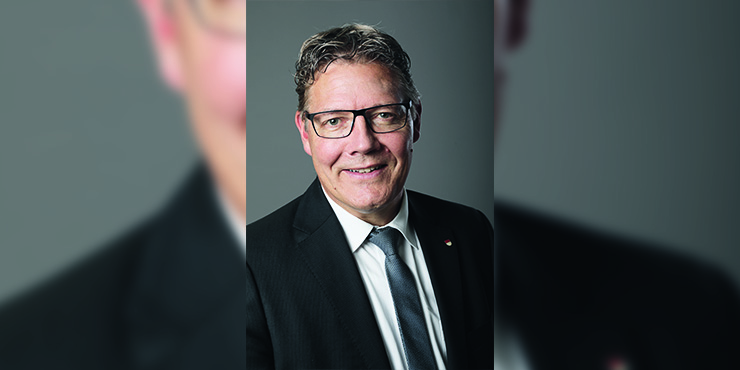"We will launch the electronic submission of building applications this year"

The Solothurn government councilor Roland Fürst, who left in the summer, campaigned during his term of office to promote digitization. Two promising pilot projects are currently running at the Building Department.
You are head of the building and justice department. What is the attraction of this office?
I've been on the road for community welfare for over 40 years. Of these, I was the mayor of the community of Gunzgen for 14 years, then a cantonal councilor for 8 years and since then a member of the government council for as long. I am attracted by the active participation and shaping of political, social and cultural issues as well as searching for and finding solutions. I not only want to manage the canton, but also to advance it. What I generally like about my department is the range of topics and the diversity of the employees in terms of expertise and character.
Where do you see the specific challenges that the office brings with it?
Spatial planning and mobility are and will remain important issues. But there are also changes in the climate, digitization and society that must be taken into account.
How far is your department specifically on the subject of digitization?
In the department, as well as in administration in general, we are still relatively new. I am surprised that the public sector has not made any significant progress in 2021. We have been trying to advance digitization in the department for a long time – accompanying workshops are intended to support this. I see digitization as a key issue that absolutely has to be implemented quickly. However, there are still obstacles, starting with data protection aspects and ending with a lack of financial or personal resources.
The canton of Aargau, for example, has introduced the digital submission of building applications with eBau. Is that also an issue in the canton of Solothurn?
It's not just an issue. The project is already well advanced: We are already working internally with a pilot project. This works fine; we will soon be ready to offer this service throughout the canton. The aim is for all interested municipalities to be able to submit building applications digitally this year. We are also currently working on the introduction of document management software (DMS). A pilot project that provides for a digital archive is currently running in the building construction department.
It feels like the canton of Solothurn is in a real building boom. Is this perception deceptive?
No, it really is. The largest projects with an investment volume of 450 million francs include the new Kebag Enova facility, 340 million francs are being built for the new citizens' hospital, and 86 million francs have been budgeted for the overall renovation of the Olten Cantonal School. But big things are also happening on the Attisholz North and South areas. An important project is Biogen's biopharmaceutical production facility in Luterbach: the first stage was 1.6 billion Swiss francs. Hopefully more stages will follow. But we also have around 2000 residential units in and around the city of Solothurn that are either planned or already under construction.
What about your own projects?
We are currently looking into building a new education campus as well as a new administration building where different locations could be concentrated. Optimizing the sports infrastructure in the city of Solothurn is also an issue.
From a cantonal point of view, are there still sufficient building land reserves to implement all of these projects?
We are currently busy with spatial planning development. Here we find that the building land reserves should be sufficient for the next 15 years. But this also means that no new land will be zoned during this period. In return, none have to be zoned out. We also have many industrial wastelands or otherwise fallow land that we can convert.
"The building department stands for solutions – not for managing problems"
What makes the canton of Solothurn so attractive for new construction projects?
On the one hand, we are very central and also offer a lot of quality of living and tranquility. The people of Solothurn particularly appreciate the Jura landscape and the diverse cultural offerings. Solothurn is also known as the most beautiful Swiss baroque city. We are also well connected to public transport and private motorized transport. And our land prices are still affordable. From an economic point of view, we have many innovative companies and niche players who are attracting attention worldwide, such as Ypsomed (insulin pump system) or Jura Elekt-roapparate (premium coffee machines).
Which construction projects have you helped shape during your tenure so far?
As a government councilor, of course, I don't work on projects myself – but I pave the political path and thus enable the start. I was most actively involved in the development of the Attisholz Süd area: As a former director of the Solothurn Chamber of Commerce, I was already involved in the test planning. One highlight is the transformation of the former Schöngrün prison into a residential complex. But I also have fond memories of the renovation of the Altes Zeughaus Museum and the indoor swimming pool at the Olten Cantonal School, where, by the way, I went to school myself. I also accompanied the project for the renovation and conversion of the Rosengarten property intensively – with this project we had to go to the federal court.
The Capuchin monastery in Solothurn, the Fridau psychiatric clinic and the Allerheiligenberg high altitude clinic are considered problem children. What exactly are the problems with these objects?
These three projects are simply not a sure-fire success. They are located in zones that do not allow every use. The Allerheiligenberg, for example, is located in the agricultural zone. There are additional usage restrictions here: the surrounding hospitals must not be allowed to compete. In addition, there is the financial outlay, which is immense for such large projects. The Capuchin monastery, for example, is a listed building. The Fridau Clinic is located together with the Allerheiligenberg in the Jura protection zone. The difficulties mentioned require a lot of patience from investors and owners.
An inventory of spatial planning is currently taking place at the cantonal level. What is the detailed plan?
The whole of Switzerland is challenged when it comes to spatial planning. The revision of the Spatial Planning Act from 2014 requires all cantons to revise the structure plans. We have already done this. Now all municipalities have to revise their local planning. We count 107 municipalities in the canton of Solothurn – it takes time before all thoughts on further development within the framework of the cantonal requirements have been made. The inward development of the settlement poses major challenges for the community. The Solothurn municipalities will have completed this process within the next five years.
What about urban sprawl in the canton of Solothurn?
In the past, people certainly paid too little attention to this – but that should apply to all of Switzerland. The municipalities supported the new spatial planning law by a majority in the run-up to the vote. What a law really means can often only be seen when it is implemented. This is also the case here – the accusation arises that the canton or the federal government would prevent a municipality from developing. In the canton of Solothurn, however, we are on the right track. The need for internal densification is now firmly anchored in the minds of those responsible for the community. The majority deal very well with the new challenges and framework conditions.
The municipalities enjoy a great deal of autonomy in the canton of Solothurn. Do you perceive these as an advantage or disadvantage in the performance of your office?
I know both sides. As a mayor, it's an advantage – as a councilor it's a disadvantage (laughs). No, seriously: The autonomy is one thing, the other is the high number of communities: We have 107. But we maintain a good exchange with the community association, so we always find solutions.
They are stepping down in the summer for health reasons. Do you already have plans for the time after that?
I will definitely continue to be active. I have already accepted various board memberships and have other open inquiries. But first I'll take care of my old sports injuries and then I'll see how things go from here.
What do you wish for the future of the building department?
The building department stands for adherence to deadlines, adherence to budgets, speedy work and high quality. It should stay that way even after my retreat. Of course, I don't just want to hand over the projects to the new hands, I also want my heart and soul to continue to flow into it. Our credo is: The building construction department stands for solutions and not for managing problems.
